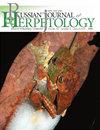Morphometric Analysis and Characterization of Peripheral Blood Cells in the Golden Tree Snake Chrysopelea ornata (Shaw, 1802)
IF 0.9
4区 生物学
Q3 ZOOLOGY
引用次数: 0
Abstract
Reptile hematology provides important information to help assessment of health conditions and other reptile physiology and for biomarker discovery. The current hematology of snake from natural habitats of Thailand with morphological measurement is still rarely explored. In the present study, the extensive investigation on the morphometric analysis and characteristics of blood cells in the golden tree snake Chrysopelea ornata (Shaw, 1802) was examined and compared between sexes. Here we found that the majority of the squamate blood cells were erythrocyte in both sexes of this snake. It had the typical erythrocyte morphology showing eclipse shape with a central nucleus without significant difference between males and females. White blood cells (or leukocytes) in the snakes were a heterogeneous group with different nucleus shape and also shared a similar size between sexes. Interestingly, the length of thrombocytes was significantly different (P 0.05): longer in the male and shorter in the female snakes. From the blood smear technique, the heterogeneous group of the snake leukocyte included azurophil, heterophils neutrophil, basophil, lymphocyte, and monocyte without eosinophil. Remarkably, the highest proportion of the snake leukocyte was lymphocyte, followed by azurophils, and neutrophil. This proportion was similar in both sexes. The results from our hematological analysis could be provided as hematology-based health monitoring of the wild population for C. ornata in our land and other countries.金树蛇Chrysopelea ornata (Shaw, 1802)外周血细胞的形态计量学分析与表征
爬行动物血液学为评估健康状况和其他爬行动物生理学以及生物标志物的发现提供了重要信息。目前,对来自泰国自然栖息地的蛇进行形态学测量的血液学研究仍然很少。在本研究中,对金树蛇Chrysopelea ornata(Shaw,1802)血细胞的形态计量学分析和特征进行了广泛的研究,并在性别之间进行了比较。在这里,我们发现这种蛇的大多数鳞片血细胞都是红细胞。红细胞形态典型,呈带中心核的日食状,男女无显著差异。蛇的白细胞(或白细胞)是一个异质性群体,具有不同的细胞核形状,性别之间也有相似的大小。有趣的是,血栓细胞的长度有显著差异(P 0.05):雄性较长,雌性较短。从血涂片技术来看,蛇白细胞的异质性组包括嗜蓝细胞、嗜中性粒细胞、嗜碱性粒细胞、淋巴细胞和无嗜酸性粒细胞的单核细胞。值得注意的是,蛇白细胞比例最高的是淋巴细胞,其次是嗜蓝细胞和中性粒细胞。这一比例在两性中是相似的。我们的血液学分析结果可以作为基于血液学的对我国和其他国家野生ornata种群的健康监测。
本文章由计算机程序翻译,如有差异,请以英文原文为准。
求助全文
约1分钟内获得全文
求助全文
来源期刊

Russian Journal of Herpetology
ZOOLOGY-
CiteScore
1.70
自引率
0.00%
发文量
29
期刊介绍:
Russian Journal of Herpetology is an international multi-disciplinary journal devoted to herpetology. Russian Journal of Herpetology accepts original papers on ecology, behavior, conservation, systematics, evolutionary morphology, paleontology, physiology, cytology and genetics of amphibians and reptiles.
Types of Contributions:
-original papers
-invited or contributed reviews on specific topics
-short communications on topics of immediate interest, new methods and ideas in progress
-notices of meetings, symposia, and short courses
-book reviews
 求助内容:
求助内容: 应助结果提醒方式:
应助结果提醒方式:


